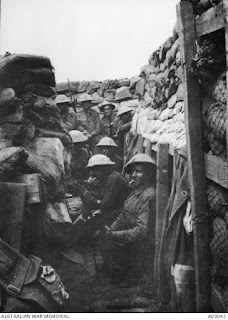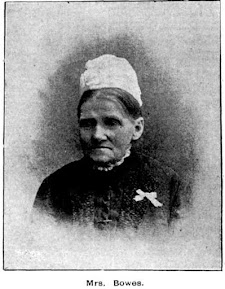A Tragic and Disasterous Failure
Many headstones and memorials throughout Rookwood Cemetery have dedications to the young men, and some woman, who enlisted, fought and died in WW1. Thousands have their name mentioned on the family plot and became a place to grieve the loss of these brave people who never came home. Over a thousand of these headstones have the word "ANZAC" engraved, hundreds have "POZIERES" and just a few actually list "FROMELLES".
Today, the 19th July 2022, is the 106th anniversary of the Battle of Fromelles.
It was the day that the troops of the 5th Australian Division stormed the German line which centred around the "Sugar Loaf" salient near the small French village of Fromelles.
Trench during Battle of Fromelles - AWM image 4094545
The plan was concocted by Sir Richard Haking, of the British Army in response to calls for a diversionary action to prevent further German Forces being transferred to the Somme some 80 kilometres south. Others involved were Major General James McCay and Brigadier General Harold "Pompey" Elliott, commanding officers of the 5th Division and 15th Brigade respectively.
All approached battle differently but as the timeframe of events dragged out "Pompey" Elliot expressed his concerns warning that the attack would be nothing short of a bloodbath.
The plan was that the Australian troops were to sieze an area of the front line of a heavily defended area after the British troops had bombarded with heavy artillery fire. Because of delays, the Germans were able to prepare knowing that an attack was imminent. They shelled the assembly areas and communications trenches causing many casualties before the attack had even commenced.
The assault on Fromelles failed due to a number of factors. These being that the Australian troops had only arrived in the area a few days prior and were exhausted from dragging guns and armaments to the front line; due to the delays in the timing of the Battle the Germans were able to prepare and arrange further reinforcements; the assault was conducted at 6pm in summer time, in broad daylight with the sun in the Allies eyes; initial losses were so great that there were insufficient men to hold the line and orders were given to ignore the German front line trenches and aim deeper. So many Officers were lost that communication failed and supervision became virtually non existent.
Another factor that contributed to the large losses was that only the initial wave of troops were issued with steel helmets and the rest had to make do with their slouch hats which proved little protection from shrapnel. The number of guns and ammunition had been reduced and operated by inexperienced soldiers - was it any wonder that the losses were so high.
Over 5,500 Australians of the 5th Division became casualties. Almost 2,000 of them were killed in action or died of wounds and some 400 were captured. The number of dead included 15 sets of brothers and one father and son. The Battle is believed to be the greatest loss by a single Division in the Australian Infantry Forces in 24 hours during the entire First World War and arguably one of the single most tragic events in the history of Australia.
Some of the men involved in this attack commemorated on Family Graves in Rookwood are...
Frederick Leslie SAINTY - S/N 2426
Photo of Headstone at family plot - author's own - apologies if illegible
Frederick enlisted in September 1915 at the age of 18. He was 5ft 9in with a fresh complexion, blue eyes, brown hair and was employed as an engineer. He was the youngest of twelve children, born in the inner west Sydney suburb of Newtown and resided in Haberfield. Frederick was remembered as a good pianist and very popular amongst his fellow troops.
He embarked on the HMAT RMS Mooltan in December 1915, trained in Egypt for the forthcoming Western Front assault, contracted illness on a few occasions and disembarked in Marseilles on 29 June 1916. Frederick was a "sapper" - one who digs trenches and lays, detects or disarms mines and was in the 14th Field Company Engineers.
His duties meant that he was in the thick of the fighting. He was killed on that fateful night. Information in Red Cross files states that Frederick was entrusted with the duty of dispatch and about a week before the Battle he had the offer of a position that would keep him away from the front, a promotion. He declined the offer preferring to stay and fight with his mates. Frederick was killed by a shell hitting the support line before the 3rd wave of action. He was buried near where he fell but in the confusion of the assault his body was never found. Frederick is commemorated at VC Corner, Australian Cemetery, Fromelles.
Frederick still lies somewhere in the fields of France like so many others. Hopefully one day his remains will be found and he can be buried with full Military honours.
William BENTLEY - S/N 3007
Photo of commemoration on family memorial - authors own
Originally from Pateley Bridge, Yorkshire, England, William arrived in Australia at the age of 16 and was living in the inner west Sydney suburb of Dulwich Hill with his parents at the time of his enlistment in July 1915 at the age of 20. He was 5ft 8in with a dark complexion, brown eyes and hair and listed as a mechanic.
William was promoted to Lance Corporal almost immediately no doubt due to his previous army service of three years. He sailed to Egypt aboard the HMAT A69 Warilda in October 1915 and then joined the 54th Battalion, had a bad case of influenza whilst in training in Egypt but once recovered was sent to France arriving like Frederick Sainty on 29 June 1916.
He was initially reported as "missing in action" during that fateful night but was later updated to "killed in action" from eye witness reports that state this information was reported back to his regiment. It was also stated that he and his mates had got over the first line of German Trenches but had to retire. William was buried near where he fell but was later recovered and reburied in the Rue-Du-Bois Military Cemetery in Fleubaix (Fromelles) France.
The retreat was sounded but those that didn't hear fought on, many to the death.
The Battle was a disastrous failure. Besides the huge losses to the Australian 5th Division of over 5,500, the British 61st Division suffered 1,547 casualties with 500 deaths. The Germans about 1500. All the more shocking as these numbers were incurred in less than 24 hours.
May they all Rest in Peace.
There are many references about the Battle of Fromelles and I have utilised information from National Archives of Australia War Records files and Australian War Memorial Red Cross files.
Please add a comment here or at the group Facebook page which can be found with a search via rookwoodcemeterydiscoveries.






A very sad but well researched post…We Will Remember Them 🌅
ReplyDeleteNever forgotten
Delete